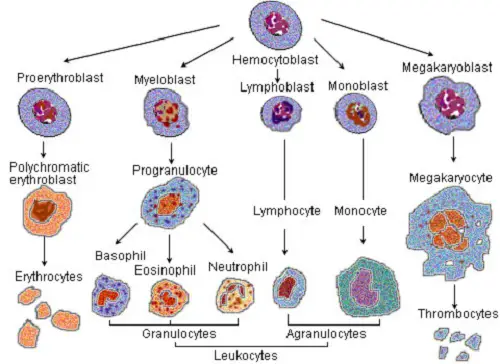
T cells (T lymphocytes) and B cells (B lymphocytes) are two key players in the adaptive immune system, working together to mount effective immune responses against pathogens. Despite their distinct functions, T cells and B cells share several fundamental similarities. This article explores these commonalities, shedding light on the coordinated efforts of these immune cells.

Origin and Maturation:
T Cells: Originate from precursor cells in the bone marrow and undergo maturation in the thymus.
B Cells: Originate from precursor cells in the bone marrow and undergo maturation in the bone marrow itself.
Elaboration: Both T cells and B cells arise from hematopoietic stem cells in the bone marrow, but they mature in different primary lymphoid organs. T cells migrate to the thymus for maturation, while B cells complete their maturation in the bone marrow.
Antigen Recognition:
T Cells: Recognize antigens presented by major histocompatibility complex (MHC) molecules on the surface of other cells.
B Cells: Recognize antigens directly, usually on the surface of pathogens.
Elaboration: Both T cells and B cells are activated by recognizing specific antigens. T cells recognize antigens presented by other cells, while B cells directly bind to antigens.
Receptor Diversity:
T Cells: Express T cell receptors (TCRs) on their surface, each T cell having a unique TCR.
B Cells: Express B cell receptors (BCRs) on their surface, each B cell having a unique BCR.
Elaboration: TCRs and BCRs are essential for antigen recognition. The diversity of receptors arises from genetic rearrangement during the development of these cells, ensuring a broad spectrum of antigen recognition.
Clonal Expansion:
T Cells: Undergo clonal expansion upon activation, producing effector T cells and memory T cells.
B Cells: Undergo clonal expansion upon activation, producing plasma cells (effector B cells) and memory B cells.
Elaboration: Both T cells and B cells proliferate rapidly after encountering their specific antigens. This clonal expansion generates effector cells for immediate immune responses and memory cells for long-term immunity.
Effector Functions:
T Cells: Mediate cell-mediated immunity, including cytotoxic T cells that directly kill infected cells and helper T cells that assist other immune cells.
B Cells: Mediate humoral immunity, producing antibodies that neutralize pathogens and mark them for destruction.
Elaboration: T cells and B cells contribute to different arms of the immune response. T cells are involved in cell-mediated immunity, while B cells are central to humoral immunity.
In conclusion, T cells and B cells, though functionally distinct, share critical features in their development, antigen recognition, receptor diversity, clonal expansion, and effector functions. Understanding these commonalities enhances our comprehension of the orchestrated immune response mounted by these cells against diverse pathogens.
Here’s a simplified comparison table highlighting the similarities between T cells and B cells:
| Aspect | T Cells | B Cells |
| Origin and Maturation | Originate in bone marrow, mature in the thymus | Originate and mature in the bone marrow |
| Antigen Recognition | Recognize antigens presented by MHC molecules | Recognize antigens directly, usually on pathogen surface |
| Receptor Diversity | Express T cell receptors (TCRs) with unique specificity | Express B cell receptors (BCRs) with unique specificity |
| Clonal Expansion | Undergo clonal expansion upon activation, producing effector T cells and memory T cells | Undergo clonal expansion upon activation, producing plasma cells (effector B cells) and memory B cells |
| Effector Functions | Mediate cell-mediated immunity: cytotoxic T cells directly kill infected cells, helper T cells assist other immune cells | Mediate humoral immunity: produce antibodies that neutralize pathogens and mark them for destruction |
| Primary Function | Cell-mediated immunity, direct action against infected cells | Humoral immunity, antibody production and antigen recognition |
| Location of Maturation | Thymus | Bone Marrow |
Note: This table provides a concise overview of the similarities between T cells and B cells. The actual immune response involves complex interactions and may vary based on the specific context and pathogens encountered.
Frequently Asked Questions (FAQ) on T Cells and B Cells:
Q1: What is the main difference between T cells and B cells?
A1: T cells and B cells are both types of lymphocytes involved in the immune response. The main difference lies in their functions—T cells primarily mediate cell-mediated immunity, while B cells are central to humoral immunity.
Q2: How do T cells and B cells recognize antigens?
A2: T cells recognize antigens presented by major histocompatibility complex (MHC) molecules on the surface of other cells, while B cells directly bind to antigens, usually on the surface of pathogens.
Q3: What is the role of clonal expansion in the immune response?
A3: Clonal expansion is the rapid proliferation of T cells and B cells after activation by specific antigens. It generates effector cells for an immediate immune response and memory cells for long-term immunity.
Q4: How are T cell receptors (TCRs) and B cell receptors (BCRs) generated?
A4: TCRs and BCRs are generated through genetic rearrangement during the development of T cells and B cells. This process results in a diverse repertoire of receptors with unique specificities.
Q5: Do T cells and B cells contribute to different types of immunity?
A5: Yes, T cells are primarily involved in cell-mediated immunity, including the direct killing of infected cells, while B cells are central to humoral immunity, producing antibodies to neutralize pathogens.
Q6: Where do T cells and B cells mature?
A6: T cells mature in the thymus, while B cells mature in the bone marrow. Both types of lymphocytes originate from precursor cells in the bone marrow.
Q7: Can T cells and B cells work together in the immune response?
A7: Yes, T cells and B cells often collaborate in the immune response. For example, helper T cells assist B cells in the production of antibodies, enhancing the overall effectiveness of the immune response.
Q8: What happens during the clonal expansion of T cells and B cells?
A8: Clonal expansion involves the rapid multiplication of T cells and B cells with receptors specific to a particular antigen. This results in a larger population of immune cells capable of responding to the antigen.
Q9: Are T cells and B cells involved in immunological memory?
A9: Yes, both T cells and B cells generate memory cells during clonal expansion. These memory cells “remember” specific antigens, providing a faster and more robust response upon subsequent exposures.
Q10: Can defects in T cell or B cell function lead to immune disorders?
A10: Yes, deficiencies or dysregulation in T cell or B cell function can result in various immunodeficiency disorders, making individuals more susceptible to infections. Understanding these cells is crucial for diagnosing and treating such disorders.
Q11: How are T cells and B cells activated during an immune response?
A11: T cells are activated when their TCRs recognize antigens presented by MHC molecules. B cells are activated when their BCRs bind directly to antigens. This activation is a key step in initiating the immune response.
Q12: Can T cells and B cells provide long-lasting immunity?
A12: Yes, the memory cells generated by T cells and B cells during clonal expansion contribute to long-lasting immunity. This is the basis for the effectiveness of vaccines in providing protection against infectious diseases.
Q13: Are T cells and B cells specific to particular pathogens?
A13: Yes, T cells and B cells are highly specific. Each T cell and B cell expresses receptors with a unique specificity for a particular antigen. This specificity ensures a targeted and precise immune response.
Q14: Do T cells and B cells play a role in autoimmune diseases?
A14: Yes, dysregulation of T cell and B cell activity can contribute to autoimmune diseases, where the immune system mistakenly attacks the body’s own cells and tissues.
Q15: Are there ongoing research efforts to understand T cell and B cell responses better?
A15: Yes, ongoing research explores the intricacies of T cell and B cell responses, aiming to uncover new insights into immune regulation, development of therapies, and advancements in vaccine design.
Q16: Can T cells and B cells cross the blood-brain barrier?
A16: T cells can enter the brain in certain situations, contributing to immune responses in the central nervous system. B cells may also enter the brain under specific conditions.
Q17: How do T cells and B cells contribute to cancer immunotherapy?
A17: T cells are central to cancer immunotherapy, including therapies that enhance the activity of cytotoxic T cells against cancer cells. B cells may also play a role in certain immunotherapeutic approaches.
Q18: Can T cells and B cells recognize and respond to the same antigen simultaneously?
A18: Yes, in certain immune responses, both T cells and B cells can recognize and respond to the same antigen, leading to a coordinated and more effective immune reaction.
Q19: What role do T cells and B cells play in the rejection of transplanted organs?
A19: T cells are major contributors to organ transplant rejection as they can recognize foreign antigens on transplanted tissues. B cells may also contribute through antibody-mediated rejection.
Q20: How do T cells and B cells contribute to the clearance of viral infections?
A20: T cells, especially cytotoxic T cells, directly target and kill virus-infected cells. B cells produce antibodies that neutralize viruses and mark them for destruction by other components of the immune system.











